Living With CatsOur member survey revealed that the huge majority of you suffer problems with cats in the garden. We've responded to this finding by testing a wide range of deterrents Even ardent cat-lovers usually admit that our feline friends can be a nuisance in gardens. Other people's cats, at least. Most of us are only too aware how the interests of gardeners can conflict with those of cats. According to a survey we carried out last year, 84 per cent of readers have at least one cat-related problem in their garden. Cats & the lawCats are recognized in law as free-roaming animals. This means their owners can't be held guilty of trespass on their behalf. However infuriatingly a cat behaves, it is an offence to cause it suffering. |
Our SurveyIn May 2003, we questioned 2821 Gardening Which? readers about cats and the problems they cause in their gardens.
|
Common ProblemsThe most common complaint by far is cats using bare soil as a toilet. 65 per cent of readers reported this problem. If only cat owners were neighbourly enough to provide their pets with somewhere to use in their own gardens, these readers would find gardening considerably more pleasurable! Other frequently cited cat crimes included fouling gravel, flattening plants and seedlings, using trees and shrubs as scratching posts, killing birds and raiding their nests. The more car-proud among you may also identify with the few readers who were aggrieved that cats sometimes left muddy paw prints on their vehicle's paintwork. So what's to be done? Initially, there are some simple steps worth trying: Impede garden access Block boundary gaps with prickly plants or prunings such as holly or berberis. Fit taut wire or string 10cm-15cm above the top of fences to make it difficult for cats to balance on them. Borders Plant closely to leave no exposed soil. Cover seed beds with netting. Use this to cover other bare areas too, or mulch with stone chippings or pebbles. Young trees Cats often use tree trunks as scratching posts. This can harm and eventually kill trees. Wrap tree guards or small-gauge chicken wire around the base of trunks as a deterrent. Ponds Cover with netting to protect fish, or create a boggy area around the edge. Containers If digging is a problem, mulch with stone chippings. If the container is at least 60cm tall, plants in it should avoid being sprayed with urine. Bird feeders Position these in a clear area of the garden, away from cover and where they will be inaccessible to cats. Fit a squirrel baffle (a downward-opening cone or biscuit tin) to the posts of bird tables to prevent cats climbing up them. Alternatively, place prickly prunings like holly beneath them - or plant something spiky. Avoid putting bird food on the ground unless you then cover it with a cage of some sort to exclude cats. Cat owners Impose a hunting curfew by keeping cats indoors throughout the night and early morning. This will also protect them from traffic and foxes. Provide a litter tray or other toilet area in your garden, and another indoors. Also train your cats to use a scratching post for claw sharpening to avoid damage to tree trunks. If, despite taking these steps, you're still having moggie troubles, consider investing in a branded cat repellent. |
Solutions Child's playThe Chapman family had a problem with their children's sand pit, which neighbourhood cats had begun to presume was for their benefit. Something had to be done for hygiene's sake, so they were keen to take part in our trial. The Chapmans assessed the Scarecrow, a motion-activated device that squirts water at whatever triggers it. Cats soon took the hint, but an unexpected bonus was the amount of fun the kids got out of deliberately setting it off during last year's long, hot summer. Dad Nigel also admitted to being accidentally soaked a few times when he forgot the device was on. He's since angled the spray so he can creep up behind it and switch it off without getting wet.  Going hi-techJeanette Footitt was fed up with cats using her garden as a toilet and lying in wait beneath the bird table. She's tried discouraging them by squirting water, erecting barriers of prickly prunings and scattering citrus peel and various granular cat repellents, all with limited success. We asked her to try out the ultrasonic Cat & Dog Repeller for three months. Although effective, it didn't keep the entire garden cat free. Also, the family found the device irritatingly noisy. Jeanette was especially sensitive to the high-pitched sound and, because birds set it off so often, she resorted to relocating it to the front garden out of earshot! Being activated so frequently also meant the batteries ran out within a month, so Jeanette recommends buying the optional extra transformer so it can be plugged into the mains. |
Solutions: II Scaredy cats?Barbara Couch's all-too-familiar gripe with cats is that they habitually dig in unplanted areas of soil, leaving their calling card. Citrus peel and numerous brands of chemical repellents have been scattered, but to no avail. Last summer she trialled 'scardy cat' plants (Coleus caninus) for us. Barbara wasn't impressed. The offending cats were so untroubled by the scent of these plants that they sauntered through the row she'd planted en route to do the usual in the dry, clear area of soil behind. One tabby even lay down among the plants to bask in the sun! The answer, Barbara quite rightly feels, is to cover the ground with more desirable plants so there isn't any bare soil for cats to use. Meanwhile, she has found that keeping bare areas constantly wet seems to do the trick.  Pong powerCats used to raid Tunja Stone's fishpond and use her seed beds as a toilet. Netting helped to put a stop to this, but nesting birds and Tunja's tubs still attracted unwelcome attention. She agreed to assess Vitax Scent-Off Gel in our trial. While it did keep cats away from her tubs, the gel didn't go very far and smelt too awful for her to contemplate using long-term. 'It reminded me of the carbolic my gran used to scrub everywhere.' The smell even drifted into the house if doors or windows were open. Her children have since created a giant spider's web from string to protect patio displays. It's effective, odour- and chemical-free - and even quite attractive! |
Cat Repellents on TestLast summer, we asked 150 cat-plagued gardeners to try out a branded deterrent for three months. Fifteen brands were each given to ten gardeners, including examples of the most widely available types. Each trialist used the product according to the supplier's instructions and gave us their verdict on its ease of use and effectiveness by completing a detailed questionnaire. Chemical repellents | Ultrasonic devices | Physical Deterrents Chemical repellentsMost aim to deter cats by irritating their noses and/or disguising the smell of previous fouling. Products are likely to be at their most potent when first applied - rain dampens their effectiveness and smells fade with time regardless of the weather. Unless you are lucky enough to break the cat's habit quickly, you may need to apply these products more than once - particularly in previously fouled areas. There are numerous brands of chemical repellents, but most contain one of only eight active ingredients - you'll usually find these specified on the packs. We put brand-leaders of each type to the test. Bio Cat-a-Pult Animal Repellent | Bio Pepper Dust | Bio Scat-a-Cat | Get Off My Garden scatter crystals | Green Bs Professional Cat Repeller | Growing Success Cat Repellent | Renardine | Silent Roar | Vitax Scent-Off Gel | 'Scardy Cat' Plant 1 Bio Cat-a-Pult Animal Repellent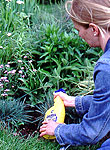
Type Liquid spray containing aluminium ammonium sulphate. Also claimed to deter dogs, birds, rabbits and other animals. top
2 Bio Pepper Dust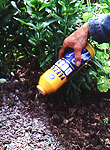
Type Black pepper powder. Also claimed to deter dogs. top
3 Bio Scat-a-Cat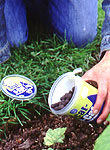
Type Granules containing citronella oil. top
4 Get Off My Garden scatter crystals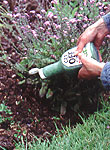
Type Jelly-like crystals containing citrus-smelling methyl nonyl ketone, said to discourage dog fouling, too. top
5 Green Bs Professional Cat Repeller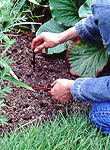
Type Citrus-scented plastic rods. |
Chemical Repellents: IIBio Cat-a-Pult Animal Repellent | Bio Pepper Dust | Bio Scat-a-Cat | Get Off My Garden scatter crystals | Green Bs Professional Cat Repeller | Growing Success Cat Repellent | Renardine | Silent Roar | Vitax Scent-Off Gel | 'Scardy Cat' Plant 6 Growing Success Cat Repellent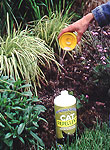
Type Granules treated with orange and garlic oils. top
7 Renardine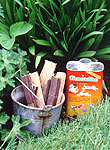
Type Liquid containing bone oil, said to repel dogs, rabbits,
foxes, moles and badgers as well. It's not applied to the ground
directly but poured onto pieces of firewood, rags or builders' sand. top
8 Silent Roar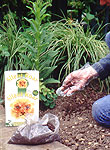
Type Pellets soaked in 'essence of lion dung' which are also said to deter deer. top
9 Vitax Scent-Off Gel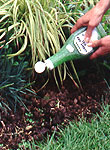
Type Jelly-like crystals impregnated with mothball-scented naphthalene, and supposed to discourage dog-fouling as well. top
10 'Scardy Cat' Plant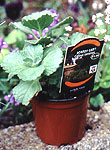
Type Tender perennial (Coleus caninus) that, once established, releases a scent said to deter dogs and foxes as well as cats. |
Ultrasonic DevicesThese battery- and mains-powered alarms emit sound at frequencies inaudible to most of us, but thought to be disliked by cats. Most are triggered by an infrared heat and movement sensor, like those on security lights, which helps prolong their battery life. Unfortunately, cats outside the sensor's line of sight (eg behind the sensor - or the shed) won't set it off. Another downside is that ultrasound doesn't pass through solid objects, so it may not always be heard by the cat in some gardens. Not to mention the obliviousness of deaf cats! Apparently, some pure-white cats and exotic breeds tend to be hard of hearing, even before they get old. The three ultrasonic devices we tried ranged in price from £30 to £60. We used them with batteries although all can also be plugged into the mains via an optional extra transformer. Cat & Dog Repeller | Catwatch | Yard Control+ 11 Cat & Dog Repeller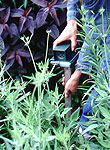
Type Infrared sensor detects movement and heat, triggering a
burst of variable ultrasound said to deter dogs and foxes as well as
cats. It's intended to monitor a 70° fan-shaped area with a radius of
12m. The manufacturer is planning to add an ID system to suit cat and
dog owners who don't want their own pets setting off the alarm. top
12 Catwatch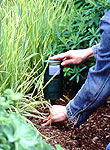
Type When triggered, this model produces ultrasound with a
slightly different frequency pattern to the Cat & Dog Repeller. The
manufacturers reckon this sound only affects cats but claim it protects
a larger area: a 100° arc up to 12m from the unit. top
Yard Control+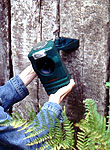
Type This has a 360° motion sensor and the frequency of sounds
emitted can be adjusted to deter its intended audience. The supplier
says this could be humans, dogs, rats, mice, squirrels, rabbits or
foxes as well as cats. They reckon its adjustable detection range is up
to 4.5m. |
Physical DeterrentsNetting and prickly twigs and leaves like holly can make effective anti-cat barriers but aren't particularly convenient to install. We decided to try a couple of more sophisticated branded barriers to see what they have to offer. Catscat | Scarecrow 14 Catscat
Type Plastic, spiky, mesh-like mat. top
15 Scarecrow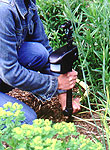
Type A motion-activated battery-powered sprinkler, designed to be
attached to a garden hose. The supplier reckons it can detect animals
as small as squirrels and the three-second pulsating spray adjusted to
reach up to 10.5m within a 100° arc. |
VerdictNone of the branded deterrents we tried worked for everyone but the ultrasonic devices and the Scarecrow were the most successful. Of these, the Cat & Dog Repeller is the cheapest. To conserve battery life, try to position it where the movement sensor won't pick up a lot of non-cat movement such as people or traffic. Alternatively, dispense with batteries and use it with a mains adapter. Or stick to using low-tech netting and twigs to protect seed beds. Whichever method you choose, clear away evidence of fouling first - this acts as a magnet for further fouling. |
ContactsBio (pbi) Cat & Dog Repeller (STV International) Catscat (Langdon) CATWatch (Concept Research) Get Off (Pet & Garden Manufacturing) Green Bs Growing Success Queenswood Renardine (Roebuck-Eyot) Silent Roar The Scarecrow (Drivall) Thompson & Morgan Vitax Yard Control+ (Benson) |